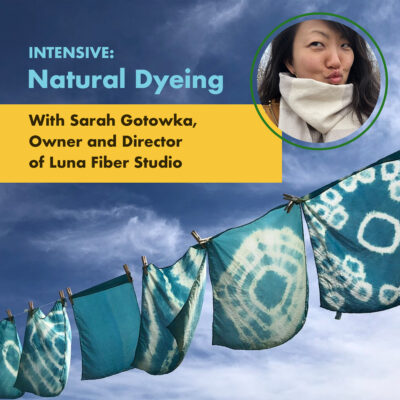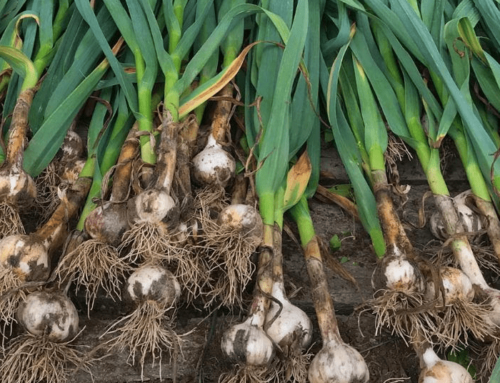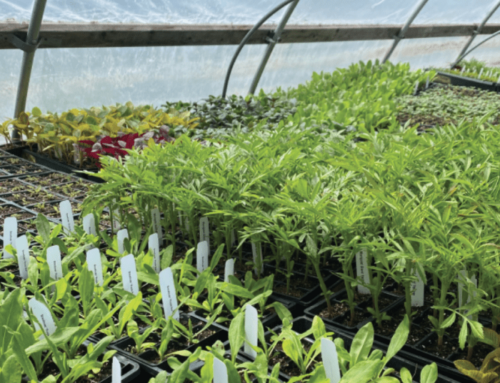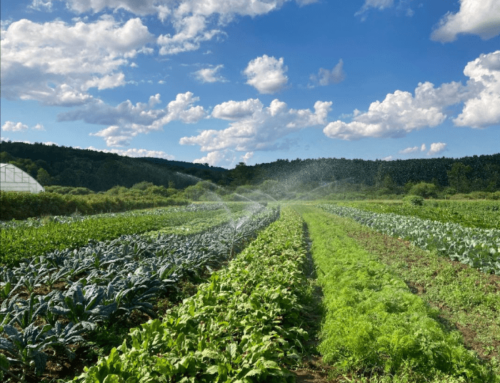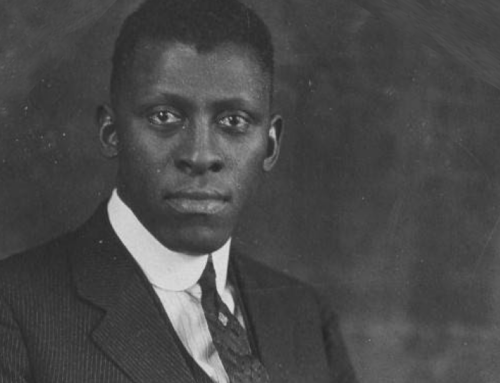By Ophelia Jackson
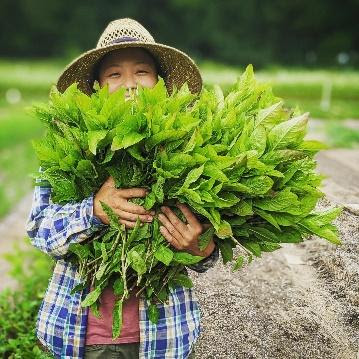
Yoko Takemura with fresh indigo plants. Photo credit: Assawaga Farm
Indigo is the blue of Picasso’s Beggar and Child—of dreams, jeans, a peacock’s cheek—the blue of a black-furred creature shines where sunlight touches the dark curve of its flank. Among the most valued and globally widespread dyes of antiquity and the present era, it is one of the few plants that contain blue dye constituents and indeed, one of the rare sources of the color blue occurring in nature.
When NOFA/Mass member and grower Yoko Takemura began to raise indigo on her small vegetable operation in 2021, though, it was about more than just a beautiful color. Assawaga Farm occupies less than an acre nestled in a quiet corner of Putnam, Connecticut, but by cultivating, harvesting, and processing the plants, it nonetheless engages with something much bigger—continuing an ancient tradition, exploring the possibility of alternatives to synthetic dyes, and reflecting an increasing interest in the dye crop among Northeastern growers today.
The earliest known use of indigo comes from northern Peru, where cotton textiles over 6,000 years old bearing traces of blue pigment have been discovered. In the decades post-Contact, indigo fueled European markets’ surging demand for American foodstuffs, dyes, and other commodities. “I make no doubt Indigo will prove a very valuable Commodity in time…” South Carolina botanist Eliza Pickney wrote in 1741 in a letter to her father. Pickney is widely credited with introducing indigo as a primary cash crop in South Carolina and the Southern colonies, including Florida and Georgia, where it was primarily exported when the industry was at its peak in the 1700’s. Ultimately short-lived, commercial indigo disappeared in the Americas just a century later, as England turned to plantations in India and the East Indies for the dye, but today small growers throughout the country are beginning to cultivate the crop once again.
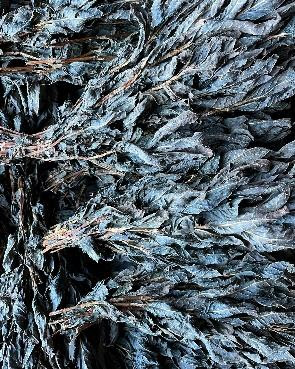
Indigo plants drying. Photo credit: Assawaga Farm
Because indigo is not a single species, moreover—but a group of over 750 annuals, biennials, and perennials all containing indicant, or dye chemical, in their leaves—the more cold-tolerant varieties (Persicaria tinctoria or Polygonum tinctorium) can be grown successfully even in the Northeastern United States, outside its historical range.
A low nutrient feeder with few pest problems, indigo grows best in neutral, well-drained soil above 50 degrees Fahrenheit, with full sun, adequate nitrogen, and weekly watering. Seeds can be started in a greenhouse 5-6 weeks before the last frost date and transplanted outside after it—or when seedlings are 6-8” tall—leaving just a bit of the stem and leaves aboveground. Peak harvesting season is in late July and August, or after 45-60 days, until the first frost—when plants are about thigh-high, with large, healthy, still-green leaves and stems standing mostly upright. At this time, the indigo can be picked, with the dye-bearing leaves separated from the stem.
There are many ways to dye with indigo, including with fresh leaves, dry leaves, composted leaves, or by extracting the indigotin pigment. Fresh leaves can be processed through blending, pounding, or salt rub methods—although they do not produce the characteristic dark blue pigment. Fructose or iron vats may be used to extract pigments, each with different ingredients. Takeumura, however, uses the centuries-old Japanese method, called sukumo, to process indigo. “… dried indigo leaves are composted and used in fermentation vats,” she explains. “These vats are alive, full of microbes that help bind the blue to the fiber. Traditional indigo craftsmen will feed these microbes with sake and grains to keep them happy!”
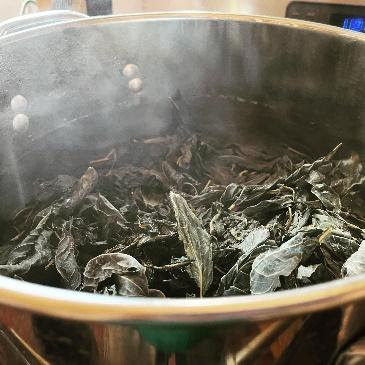
Indigo processing. Photo credit: Assawaga Farm
An important cultural tradition dating back to the seventeenth century, indigo dyeing—called azimone in Japan—gives Takemura a sense of connection to her home country. It is, however, also an expression of environmental consciousness, ethos, and concern for the future. She writes, “…we may think of fast fashion, large amounts of waste, worker exploitation, etc. but rarely do we think about the colors on our clothing or bags or tablecloths, which are most likely obtained from synthetic dyes. These dyes pollute waterways and present health risks for people who work with them.” Modern clothing and textile industries manufacture their products cheaply and quickly, but this efficiency comes at a high human and environmental cost. Polyester production for textiles released about 1.5 trillion pounds of greenhouse gasses in 2015, for example, and the need for more sustainable alternatives is central to many growers’ decision to cultivate dye crops.
Indigo is one of the most practical and environmentally-friendly dyes, and learning to cultivate, harvest, and dye with it offers a unique opportunity—to deepen and expand the grower’s relationship with the land, develop a creative practice, connect with an ancient tradition, and explore alternatives to an industry threatening environmental and human health today.
For those interested in taking part in this tradition and mission, Sarah Gotowka, owner and director of Luna Fiber Studio, a natural textile studio, will present an intensive workshop on natural dying with local plants and indigo, as well as growing and processing techniques, at the 2022 NOFA Summer Conference.
Natural Dyeing Intensive Workshop Description
Join Sarah Gotowka for a morning of natural dyeing. The day will begin with a color walk, as we identify and discuss the pigment bearing properties of local plants. Participants will then jump into working with indigo: how to cultivate, harvest and extract dye from the plant, and learn about its many complex histories from around the world. Sarah will demonstrate how to attain turquoises and aqua marines from fresh plants grown at Hampshire College Farm, as well as several surface design techniques. If you are interested in dyeing your own cloth, please visit the workshop description (click on the “Sunday” tab and then click on the 8:00am intensive workshop for a description) for a link containing instructions on how to prepare your cloth, or come prepared to purchase a small silk hankie for $5.
The intensive workshop session runs from 8:00am to 11:30am on Sunday August 7th, 2022 at Hampshire College in Amherst, MA. There is an additional $75 fee to participate in this hands-on intensive workshop once general admission to the NOFA Summer Conference has been purchased. Registration for the conference is open now, and is available on a sliding scale from $50-$250. For more information and to register visit: nofasummerconference.org
About the Author:

Sources:
https://www.science.org/doi/10.1126/sciadv.1501623
https://www.assawagafarm.com/about
http://www.rickettsindigo.com/
http://fibershed.org/wp-content/uploads/2018/01/indigo-planting-harvesting-nov2017.pdf
https://www.jstor.org/stable/pdf/4254039.pdf
https://www.nps.gov/chpi/learn/historyculture/eliza-lucas-pinckney.htm
http://nationalhumanitiescenter.org/pds/becomingamer/peoples/text5/elizapinckney.pdf
https://www.npr.org/2011/11/07/142094103/indigo-the-indelible-color-that-ruled-the-world
http://epicworldhistory.blogspot.com/2012/06/indigo-in-americas.html
https://www.wri.org/insights/apparel-industrys-environmental-impact-6-graphics

